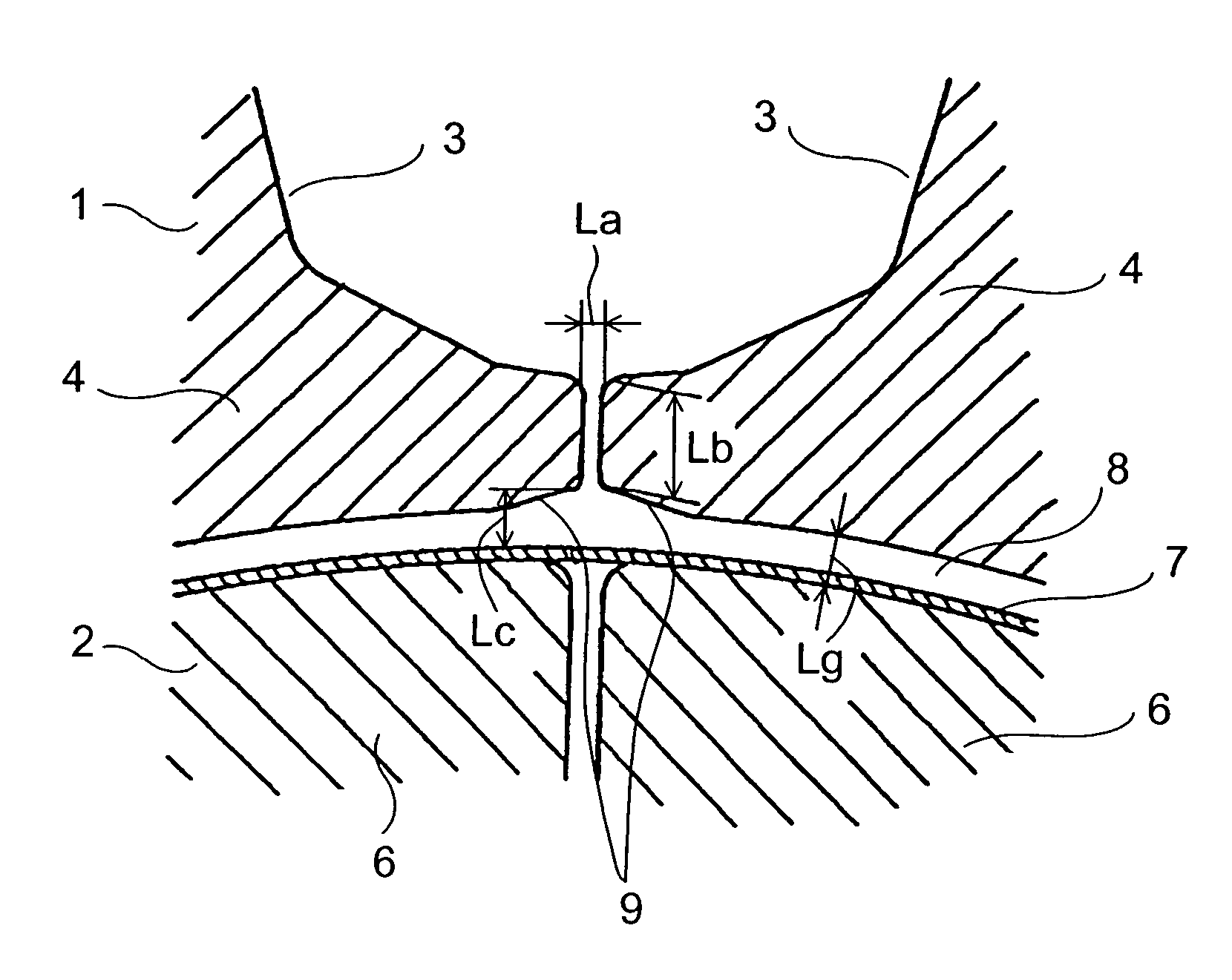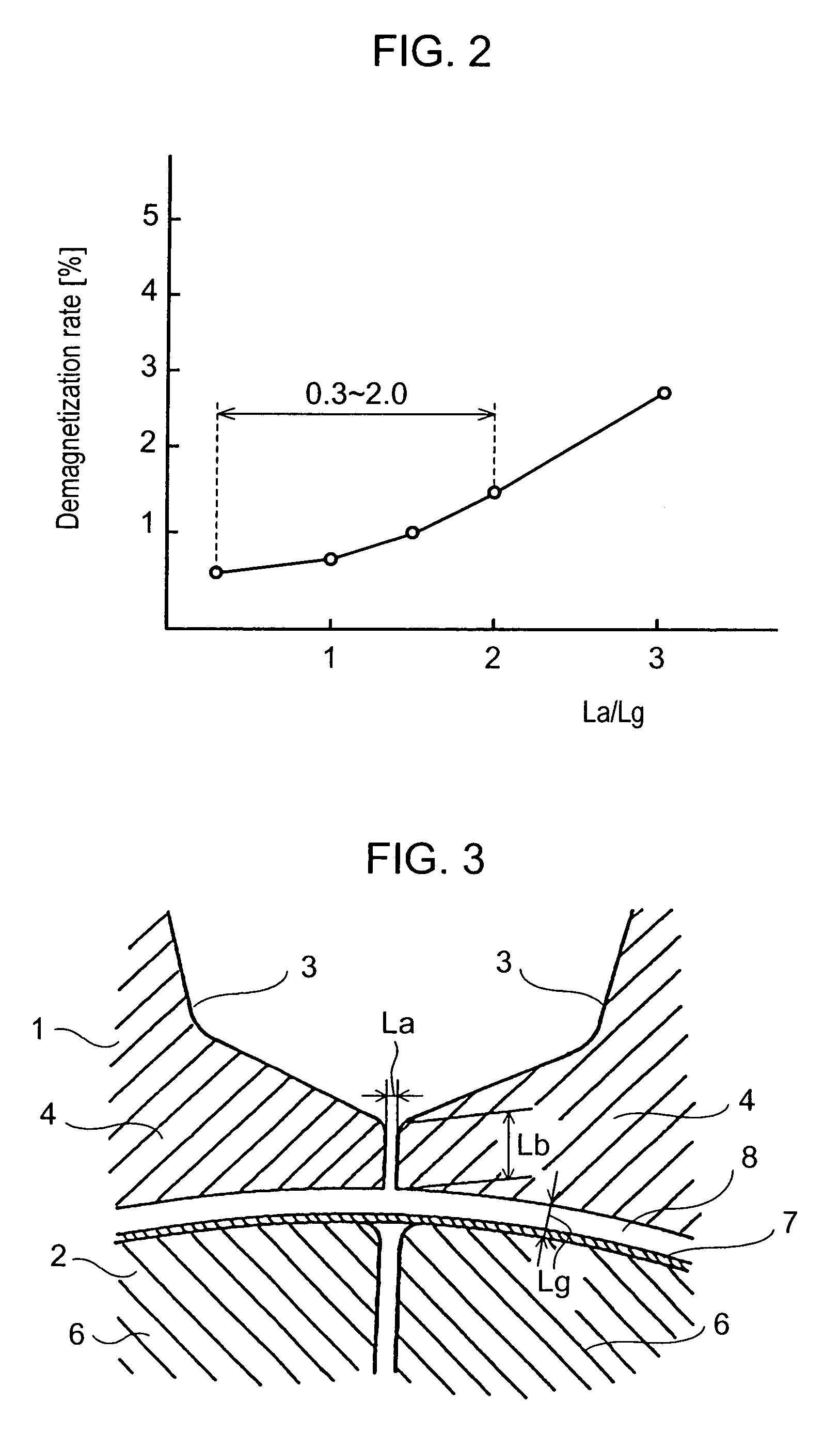Permanent magnet synchronous motor
a permanent magnet, synchronous motor technology, applied in the direction of magnetic circuit rotating parts, magnetic circuit shape/form/construction, windings, etc., can solve the problems of increasing the leakage magnetic flux between teeth, rotor magnets are not easily subjected to demagnetizing magnetic field, and stator edges may interfere with each other
- Summary
- Abstract
- Description
- Claims
- Application Information
AI Technical Summary
Benefits of technology
Problems solved by technology
Method used
Image
Examples
exemplary embodiment 1
[0040]The first exemplary embodiment of the present invention is demonstrated hereinafter with reference to FIG. 1 and FIG. 2.
[0041]In FIG. 1, stator 1 comprises divided cores 3 in a quantity corresponding to a number of slots. Teeth 4 of respective divided cores 3 are wound with coils (not shown) independently, i.e., the concentrated winding method is employed. Rotor 2 comprises rotor core 5 formed of laminated silicon steel sheet and permanent magnets 6 made of plurality of ferrite magnets, where magnets 6 are fixedly mounted to the outer wall of rotor core 5. A rotary shaft (not shown) extending through and fixed to the center of rotor core 5 is journaled by a bearing. Hollow cylinder 7 made of stainless steel sheet is fit onto the outer wall of rotor 2, or a reinforcing tape is wound around the outer wall so that necessary strength against centrifugal force is obtained.
[0042]The motor shown in the drawing has four pairs of polarity (=n), rotor 2 has eight permanent magnets (=2 n...
exemplary embodiment 2
[0047]A permanent magnet synchronous motor in accordance with the second exemplary embodiment is demonstrated hereinafter with reference to FIG. 3 and FIG. 4. The like elements used in the first embodiment bear like reference marks, and the descriptions thereof are thus omitted here.
[0048]As illustrated in FIG. 3, La and Lb are set to meet the relations of:
0.3 Lg<La<2.0 Lg, and 2 Lg<Lb<5 Lg,
where La=clearance between teeth 4 and 4,[0049]Lb=depth of edge of tooth 4 of stator 1, and[0050]Lg=air gap 8 between stator 1 and rotor 2.
[0051]In the construction discussed above, in addition to the arrangements done in the first embodiment, tooth depth Lb is set at greater than two times the air-gap Lg, thereby further restraining the leakage flux from flowing toward rotor 2. As a result, the withstanding force against the demagnetization can be increased. Since Lb is set at less than 5 Lg, the leakage flux shorting between teeth 4 and 4 does not grow too much, so that the motor o...
exemplary embodiment 3
[0054]A permanent magnet synchronous motor in accordance with the third exemplary embodiment is demonstrated hereinafter with reference to FIG. 5.
[0055]In FIG. 5, in addition to the arrangements done in the second embodiment shown in FIG. 3, parts of the edges facing each other of the adjacent teeth 4 and 4 are cut away on their rim sections that face (i.e., are closest to) rotor 2, and the cut-away section is called bevel 9. (A clearance between tooth edge 4 and rotor 2 is referred to as Lc.)
[0056]Bevel 9 can be provided only on the trailing-side edge with respect to the rotating direction of the rotor 2 out of the edges of teeth opposing each other.
[0057]The air gap on the edges of teeth 4 can be enlarged by providing bevel 9, and this can restrain the demagnetizing magnetic flux from flowing toward the rotor. As a result, the same effect is obtainable.
[0058]At the edge of tooth 4 where the rim side facing the rotor 2 has been cut away, the other side facing away (farthest) from t...
PUM
 Login to View More
Login to View More Abstract
Description
Claims
Application Information
 Login to View More
Login to View More - R&D
- Intellectual Property
- Life Sciences
- Materials
- Tech Scout
- Unparalleled Data Quality
- Higher Quality Content
- 60% Fewer Hallucinations
Browse by: Latest US Patents, China's latest patents, Technical Efficacy Thesaurus, Application Domain, Technology Topic, Popular Technical Reports.
© 2025 PatSnap. All rights reserved.Legal|Privacy policy|Modern Slavery Act Transparency Statement|Sitemap|About US| Contact US: help@patsnap.com



